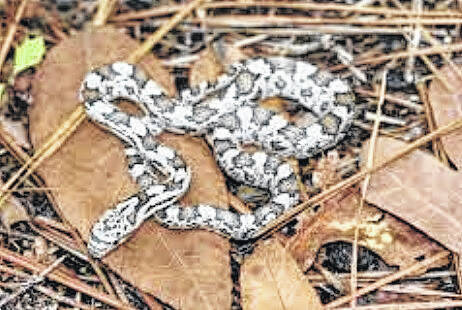Some readers may (understandably) get tired of my “leave the leaves” mantra. On the other hand, most people enjoy songbirds and butterflies, for example, and are willing to make some changes to support their survival. Not every wild creature is so charismatic and appealing. Let’s take, for example, rattlesnakes.
Half of the people reading this article just involuntarily shuddered at the thought.
I know many people hate all snakes, and fear rattlesnakes in particular. North Carolina has three native species of rattlesnakes: the Eastern Diamondback, the Timber Rattler, and the Pigmy rattlesnake.
Did you know that all three species are protected under the NC Endangered Species Act?
The Eastern Diamondback is listed as Endangered and the Timber and Pigmy are listed as species of Special Concern due to population decline. The Sandhills is the natural range for both the Timber and Pigmy rattlesnake. According to the NC Wildlife Commission, the Timber rattler, which has highly toxic venom, is actually reluctant to bite or strike, and deaths from bites are rare. Rattlers eat primarily small rodents, such as mice and squirrels, lizards and frogs, and even birds in the case of Timber rattlers. Rattlesnakes are reptiles, however they are ovoviviparous, giving birth to live young rather than laying eggs. The natural lifespan of a rattlesnake can be quite long: 10 to 25 years. Rattlesnakes, like most snakes, are important predator species of small mammals.
Natural forestlands are their main habitat, and loss of those natural areas, as well as being killed by humans intentionally or by accident (ie., run over by a car) are causing their decline.
Is it important to protect a species from population decline or extinction, especially an animal that is potentially dangerous such as a rattlesnake? I answer a resounding “Yes!”
Population declines in native species is an indicator that the ecosystem is beginning to fail. Species are inexorably connected, so a decline in one will trigger the loss, or the increase, of others within that ecosystem. The balance of the ecosystem is thrown off, causing a domino effect of cascading problems in the ecosystem.
A well-known example of this was the loss, then later restoration, of wolves in Yellowstone National Park. Wolves were eliminated from the park in 1926, throwing the system off balance in unforeseen ways which negatively impacted the entire ecosystem. Elk populations increased, and over grazing caused degradation of slopes and stream sides, and loss of habitat for everything from birds, to reptiles and amphibians, and even fish species. Tree and shrub growth was suppressed from Elk feeding, impacting songbirds and insect populations. The removal of the one critical species, wolves, caused severe degradation of the ecosystem throughout the park. Once wolves were returned the park in 1995, a healthy balance returned and the ecosystem began to heal.
The intentional killing of venomous snakes by humans also often results in the death of mis-identified snakes. I recently identified a juvenile rat snake from a photograph sent to me. Rat snakes are non-venomous and very beneficial snakes. The same photo was mis-identified by another person as a small timber rattler. The snake was found in an area well outside the timber rattlers’ natural range, which should have been a clue it was not a rattlesnake. Luckily, the snake was able to escape the area unharmed.
What can a non-snake loving, but ecologically considerate person do to avoid run-ins with Mr. No Shoulders?
Around your home, eliminate potential habitat favored by snakes, and encourage them to look elsewhere to set up house. Brush piles make great habitat for many species, including birds, rabbits, and reptiles, but keep these well away from the house and landscape where people congregate if you’re concerned about snakes. Piles of bricks and pavers are favorite hangouts (I have a black snake living in a pile of pavers in my own yard), and construction material such as stacked siding looks like an invitation to Jake the Snake to move in.
In general, keeping mulch to 2-3 inches deep and shrubbery and plants well managed, creating open, airy spaces, is discouraging for snakes who are mainly looking for places to hide.
As humans, we often want to change the natural world to make us feel safe, making it neat and tidy. We have to remind ourselves we are simply passengers on this earth, and caretakers for other living things we share it with. With thoughtfulness, knowledge and understanding, we can create spaces where we can all thrive. For more information about managing wildlife and landscaping tips, contact NC Cooperative Extension, Richmond County Center at 910-997-8255, visit our website Richmond.ces.ncsu.edu, and follow us on Facebook.

